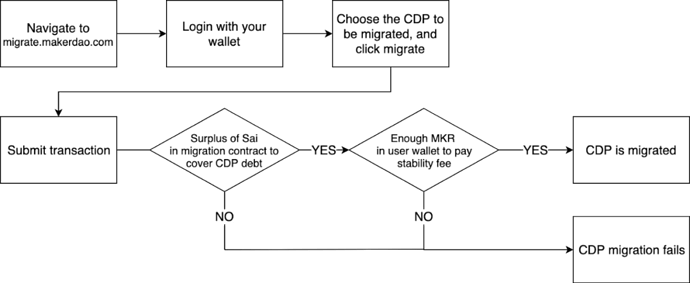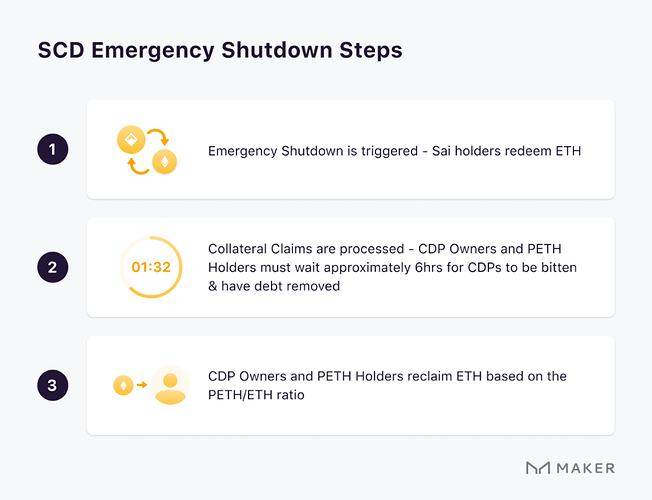自 2019 年 11 月 18 日 Maker 成功启动多抵押 Dai 以来,逐渐关闭单抵押 Sai 旧系统一直是 Maker 治理计划的一部分。目前将近 90% 的 Sai 已经成功迁移到多抵押 Dai 系统,Maker 社区决定于 2020 年 4 月 24 日启动执行投票,由 MKR 持有者表决是否正式关闭单抵押 Sai 系统 。
鉴于单抵押 Sai 旧系统关闭的重要性,我们为 Sai 持有者和 CDP 持有者编写了以下完整指南。
1. 什么是单抵押 Sai 正式关闭?
在单抵押 Sai 启动正式关闭后,CDP 持有者和 Sai 持有者将进入全局清算,确保所有 Sai 持有人和 CDP 持有者能够以目标价格赎购对应的抵押资产净值。
2. 为何关闭单抵押 Sai?
多抵押 Dai 已经包含了单抵押 ETH 和更多资产类型,关闭单抵押 Sai 具有如下益处:
- 多抵押 Dai 采用拍卖进行清算,降低坏账风险。
- 可以消除用 MKR 偿还 Sai 债务的摩擦。
- 释放更多 ETH 到多抵押系统中发行 Dai。
- 可以正式关闭 Sai <-> Dai 升级的通道。
- 减少今后单抵押 Sai 的治理和风险管理。
3. 我还有 Sai,如何升级?
官方升级渠道 (migration.makerdao.com) 上 Sai -> Dai 的互换已经关闭。
在启动正式关闭之前,Sai 持有者可以通过 1inch.exchange 、 Paraswap.io 、 Uniswap.exchange 和 Kyberswap.com 等兑换平台以市场价将 Sai 兑换为 Dai 。
正式关闭启动后,Sai 持有者可以通过赎回面板以 1 美元的价格赎购等值 ETH 抵押品。未兑换的单抵押 Sai 将以冻结喂价成为固定比例 ETH 的兑换凭证,随 ETH 价格变化而浮动。
4. 我还有 CDP,如何升级?
CDP 持有者请尽快通过官方升级渠道 migrate.makerdao.com (仍有部分流动性)将 CDP 迁移到多抵押 Dai 金库。
另外, CDP 持有者也可以在兑换平台选择最优汇率将 Dai 兑换成 Sai,偿还债务以关闭 CDP 仓位,再将取回的 ETH 存入多抵押 Dai 系统中,完成手动升级。
如果 CDP 持有者未能在触发正式关闭之前迁移 CDP ,则需要在正式关闭触发等待 6 个小时后才能取回其抵押品净值。期间主要进行链上未偿债务的清算。
5. 我有部分 PETH,如何换成 ETH?
如果你是 PETH 持有者,请尽早换成 WETH 或 ETH。为了使系统在清算时有足额的抵押品,在正式关闭触发后,PETH 会进行增发缓冲,PETH/ETH 比率会立即下降,直到所有未偿债务完成后恢复。
6. 单抵押 Sai 正式关闭流程
步骤1:触发正式关闭,Sai 持有者以冻结价格赎购抵押品
一旦触发正式关闭,ETH 喂价会立即冻结,CDP 持有者在清算期间将无法再抵押 ETH 生成 Sai。Sai 持有者可以立即以 1 美元的价格赎购 ETH 抵押品。CDP 持有者能够从 CDP 中提取与其净值相对应的 PETH,但此时无法兑换为 WETH 和 ETH。
步骤2:6 小时等待期,结算未偿债务的 CDP
触发正式关闭后,将有 6 个小时的等待期用于结算未偿债务的 CDP(等待期可以通过治理投票更改),计算所有 CDP 持有者拿回抵押品的比例。
步骤3:CDP 持有者赎回抵押品
6 小时等待期结束,所有 CDP 持有者均可取回债仓内的 ETH 净值。
7. 单抵押 Sai 的正式关闭会影响多抵押 Dai 吗?
单抵押 Sai 的正式关闭不会对多抵押 Dai 有太大影响。如果全局清算触发时,多抵押系统中的升级合约中已无待升级的 Sai,那么多抵押 Dai 系统无需任何行动。如果多抵押 Dai 系统的升级合约里仍有部分未升级的 Sai (届时将成为可兑换固定比例 ETH 的凭证),取决于 ETH 的价格变化,MKR 治理或许需要拍卖清算升级合约里的 Sai 资产。


